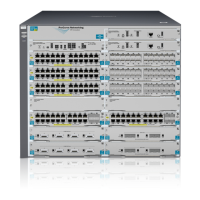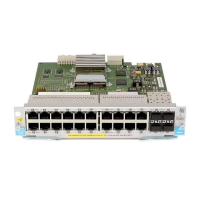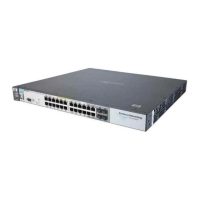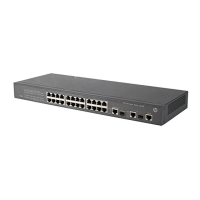3-69
Multiple Instance Spanning-Tree Operation
Troubleshooting an MSTP Configuration
MST Config Error BPDUs Number of BPDUs received from a neighbor bridge with inconsistent MST configuration
information. For example, BPDUs from a transmitting bridge may contain the same MST
configuration identifiers (region name and revision number) and format selector as the
receiving bridge, but the value of the Configuration Digest field (VLAN ID assignments to
regional IST and MST instances) is different. This difference indicates a probable
configuration error in MST region settings on the communicating bridges. The received
BPDU is still processed by MSTP.
This counter is maintained by the CIST (default MST instance 0) on a per-port basis.
Looped-back BPDUs Number of times a port has received self-sent BPDU packets as the result of an external
loop condition in which the BPDUs were looped back to the originating transmission port.
The received BPDU is still processed by MSTP and the port changes to a blocked state.
This counter is maintained by the CIST (default MST instance 0) on a per-port basis.
Starved BPDUs Number of times that no BPDUs are received within the scheduled interval (three times the
Hello Time value configured with the spanning-tree hello-time command) from a
downstream CIST-designated peer port on the CIST root, alternate, or backup port. As a
result, the “starved” port triggers a spanning-tree topology regeneration.
This counter is maintained by the CIST (default MST instance 0) on a per-port basis.
Starved MSTI MSGs Number of times that no BPDUs are received within the scheduled interval (three times the
Hello Time value configured with the spanning-tree hello-time command) from a
downstream MSTI-designated peer port on the MSTI root, alternate, or backup port. As a
result, the “starved” port triggers a spanning-tree topology regeneration.
This counter is maintained by the CIST (default MST instance 0) on a per-port basis.
Exceeded Max Age
BPDUs
Number of times that a BPDU packet is received from a bridge external to the MST region
with a Message Age value greater than the configured value of the Max Age parameter
(spanning-tree maximum age command). This may occur if the receiving bridge is located
too far from the root bridge (beyond the configured size of the spanning-tree domain on the
root bridge) or if a BPDU packet with invalid root information is continuously circulating
between bridges in a spanning-tree domain and needs to be aged out.
This counter is maintained by the CIST (default MST instance 0) on a per-port basis.
Exceeded Max Hops
BPDUs
Number of times that a BPDU packet is received from a bridge internal to the MST region
with a CIST Remaining Hops value less than or equal to 1. This may occur if the receiving
bridge is located too far from the CIST regional root bridge (beyond the configured size of
the MST region on the CIST regional root bridge) or if a PDU packet with invalid CIST regional
root bridge information is continuously circulating between bridges in the MST Region and
needs to be aged out.
This counter is maintained by the CIST (default MST instance 0 in the region) on a per-port
basis.
Field Description
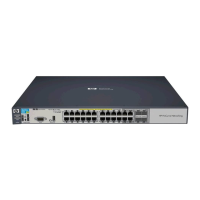
